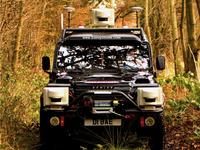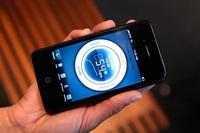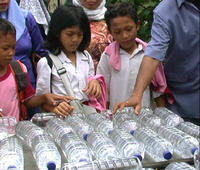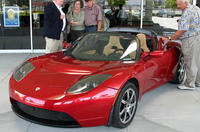-
Also noted
Radar seeing through walls | Computer virus did not target US drone fleet: general | Salmon-Killing Virus Seen for First Time in the Wild on the Pacific Coast | Irvine Sensors Signs Definitive Agreement to Sell Thermal Imaging Business | SAIC Partners With McAfee to Offer Enterprise Ready Protection From Zero Day and Reconnaissance Attacks
-
-
Software restricts access to sensitive to specific locations
Researchers have created software to remotely put smart phones under lockdown — an innovation that could aid labs doing sensitive research, secure government and military facilities, and keepers of medical records
-
-
Global Security Challenge grand final 24-25 October
Global Security Challenge grand final will be held in London 24-25 October; six start-ups and six SMEs will compete for a prize fund of $500,000
-
-
Robotic car allows drivers to work while driving

The overall cost of road congestion in the United Kingdom to business is likely to rise to £23-24 billion a year within the next fifteen years; increasing public transport capacity may help, but experts believe that, with people unwilling to give up cars, the solution is autonomous vehicles: they make road journeys safer, more efficient, and allow people to do work while on their way to the office
-
-
Mobile consumer devices transmit vital signs

Researchers turn a smart phone into a medical monitor; an app for smart phones, and eventually tablet devices, is turning these mobile devices into sophisticated medical monitors able to capture and transmit vital physiological data
-
-
Teaching sensors to think for themselves
There is a major problem with sensors: data overload; as sensors gather more and more information, it has become increasingly difficult for human users to separate out what is relevant from what is not; two U Vermont researchers received a grant from DARPA to teach sensors what to look for — and what not to look for
-
-
Safe, efficient cookstoves for earthquake survivors

316,000 people were killed and more than one million made homeless by the 12 January 2010 magnitude 7.0 quake that left the capital city of Port-au-Prince in ruins; many of the displaced Haitians still live in tent cities, where even simple tasks such as cooking are a challenge; scientists hope to find the safest and most energy-efficient way for earthquake survivors to cook
-
-
Solar UV disinfects drinking water

More than 800 million people around the world lack access to clean water; the water available for people to drink in many developing countries has not been treated to remove contaminants, including pathogenic microorganisms; half of the world’s hospital beds are occupied by people who are sickened by the water they drink; Purdue University researchers have invented a water-disinfection system that uses the sun’s ultraviolet radiation to inactivate waterborne pathogens
-
-
E-textiles now come with memory-storing fiber
E-textiles could help soldiers, first responders — but also the sick and infirm; the integration of electronics into textiles is a growing field of research that may soon enable smart fabrics and wearable electronics
-
-
Shells tracked by radar
With the high costs of live fire training, the Pentagon wanted a shell-scoring system, and commissioned Cambridge Consultants to develop one; after fourteen months of development, the company unveiled its holographic radar scoring system, the Land and Surface Target Scorer (LSTS)
-
-
Anti-magnet: to protect ships' hulls from mines
Researchers have created a new type of magnetic cloak which shields objects from magnetic fields — at the same time that it prevents any internal magnetic fields from leaking out; this “antimagnet” could be used to protect a ship’s hulls from mines that detonate when a magnetic field is detected
-
-
Proton-based transistor could let machines communicate with humans
Devices humans use, from light bulbs to iPods, send information using electrons; human bodies and all other living things, on the other hand, send signals and perform work using ions or protons; researchers build a novel transistor that uses protons, creating a key piece for devices that can communicate directly with living things
-
-
Future electric vehicle to run unlimited distances

Electrically powered vehicles (EV) are promising environmentally friendly alternatives for combustion engine-based automobiles; batteries used in present-day EV, however, limit the continuous running distance from one charge; researchers propose a potentially revolutionary solution for powering EVs capable of running unlimited distances
-
-
New vest offers GPS tacking and other information
Canadian company Laipac Technology is showing its S911 GPS Vest which the company describes as “a high coverage assault protection designed for military, tactical law enforcement and VIP personnel that demand the highest protection.”
-
-
Laser device detects IEDs

Researchers have developed a laser that could detect roadside bombs — the deadliest enemy weapon U.S. and coalition soldiers encountered in Iraq and Afghanistan; the laser, which has comparable output to a simple presentation pointer, potentially has the sensitivity and selectivity to canvas large areas and detect improvised explosive devices
-
More headlines
The long view
Autonomous Vehicle Technology Vulnerable to Road Object Spoofing and Vanishing Attacks
Researchers have demonstrated the potentially hazardous vulnerabilities associated with the technology called LiDAR, or Light Detection and Ranging, many autonomous vehicles use to navigate streets, roads and highways. The researchers have shown how to use lasers to fool LiDAR into “seeing” objects that are not present and missing those that are – deficiencies that can cause unwarranted and unsafe braking or collisions.
Tantalizing Method to Study Cyberdeterrence
Tantalus is unlike most war games because it is experimental instead of experiential — the immersive game differs by overlapping scientific rigor and quantitative assessment methods with the experimental sciences, and experimental war gaming provides insightful data for real-world cyberattacks.
Prototype Self-Service Screening System Unveiled
TSA and DHS S&T unveiled a prototype checkpoint technology, the self-service screening system, at Harry Reid International Airport (LAS) in Las Vegas, NV. The aim is to provide a near self-sufficient passenger screening process while enabling passengers to directly receive on-person alarm information and allow for the passenger self-resolution of those alarms.
Falling Space Debris: How High Is the Risk I'll Get Hit?
An International Space Station battery fell back to Earth and, luckily, splashed down harmlessly in the Atlantic. Should we have worried? Space debris reenters our atmosphere every week.
Testing Cutting-Edge Counter-Drone Technology
Drones have many positive applications, bad actors can use them for nefarious purposes. Two recent field demonstrations brought government, academia, and industry together to evaluate innovative counter-unmanned aircraft systems.
Strengthening the Grid’s ‘Backbone’ with Hydropower
Argonne-led studies investigate how hydropower could help add more clean energy to the grid, how it generates value as grids add more renewable energy, and how liner technology can improve hydropower efficiency.
The Tech Apocalypse Panic is Driven by AI Boosters, Military Tacticians, and Movies
From popular films like a War Games or The Terminator to a U.S. State Department-commissioned report on the security risk of weaponized AI, there has been a tremendous amount of hand wringing and nervousness about how so-called artificial intelligence might end up destroying the world. There is one easy way to avoid a lot of this and prevent a self-inflicted doomsday: don’t give computers the capability to launch devastating weapons.
The Tech Apocalypse Panic is Driven by AI Boosters, Military Tacticians, and Movies
From popular films like a War Games or The Terminator to a U.S. State Department-commissioned report on the security risk of weaponized AI, there has been a tremendous amount of hand wringing and nervousness about how so-called artificial intelligence might end up destroying the world. There is one easy way to avoid a lot of this and prevent a self-inflicted doomsday: don’t give computers the capability to launch devastating weapons.
